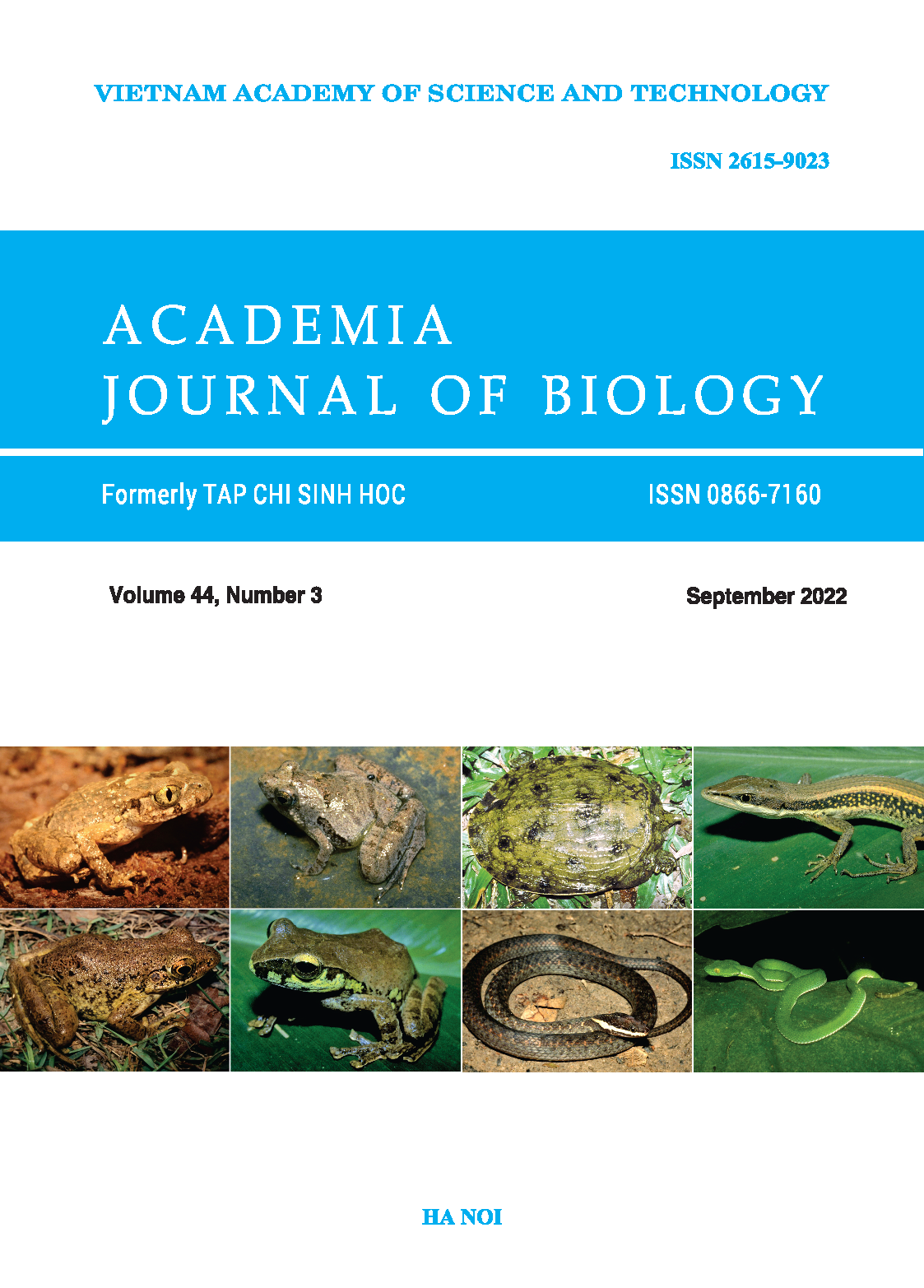Morphological and molecular characterisations of \(\textit{Scutellonema brachyurum}\) (Steiner, 1938) Andrassy, 1958 from the western highlands, Vietnam
Authors
DOI: https://doi.org/10.15625/2615-9023/17066Keywords:
first report, Western Highlands, taxonomy, D2-D3, 28S, molecular, VietnamReferences
Abadi S., Azouri D., Pupko T. & Mayrose I., 2019. Model selection may not be a mandatory step for phylogeny reconstruction. Nature communications, 10: 1–11.
Altschul S. F., Madden T. L., Schäffer A. A., Zhang J., Zhang Z., Miller W. & Lipman D. J., 1997. Gapped BLAST and PSI-BLAST: a new generation of protein database search programs. Nucleic Acids Research, 25: 3389–3402.
Anderson M. J., Gorley R. N. & Clarke K. R., 2008. PERMANOVA+ for PRIMER: Guide to software and statistical methods. UK, pp. 214.
Andrássy I., 1958. Hoplolaimus tylenchiformis Daday, 1905 (Syn. H. coronatus Cobb, 1923) and the genera of the subfamily Hoplolaiminae Filipjev, 1936. Nematologica, 3: 44–56.
Coyne D. L., Talwana H. A. L. & Maslen N. R., 2003. Plant-parasitic nematodes associated with root and tuber crops in Uganda. African Plant Protection 9:
–98.
De Ley P., Felix M. A., Frisse L., Nadler S., Sternberg P. & Thomas W. K., 1999. Molecular and morphological characterisation of two reproductively isolated species with mirror-image anatomy (Nematoda: Cephalobidae). Nematology, 1: 591–612.
Huelsenbeck J. P. & Ronquist F., 2001. MRBAYES: Bayesian inference of phylogenetic trees. Bioinformatics, 17: 754−755.
Kolombia Y. A., Karssen G., Viaene N., Kumar P. L., Joos L., Coyne D. L. & Bert W., 2017. Morphological and molecular characterisation of Scutellonema species from yam (Dioscorea spp.) and a key to the species of the genus. Nematology, 19: 751–787.
Nguyen H. T., Le T. M. L., Nguyen T. D., Liebanas G., Nguyen T. A. D. & Trinh Q. P., 2019a. Description of Geocenamus vietnamensis sp. n. (Nematoda: Merliniidae) from Vietnam. Journal of nematology 51: e2019–25.
Nguyen H. T., Nguyen T. D., Le D. H., Nobleza N. & Trinh Q. P., 2019b. Diversity of plant-parasitic nematodes on medicinal plants in Melinh station for biodiversity, Vinh Phuc province, Vietnam. Academia Journal of Biology, 41: 19–24.
Nguyen H. T., Trinh Q. P., Couvreur M., Singh P. R., Decraemer W. & Bert W., 2019c. Description of Rotylenchus rhomboides n. sp. and a Belgian population of Rotylenchus buxophilus (Tylenchomorpha: Hoplolaimidae). Journal of Nematology, 51: 1–20.
Nguyen H. T., Trinh Q. P., Couvreur M., Singh P. R., Decraemer W. & Bert W., 2019d. First Report of Scutellonema brachyurus (Steiner, 1938) Andrassy, 1958 and Occurrence of Meloidogyne incognita (Kofoid & White, 1919) Chitwood, 1949 in Belgium. Journal of Nematology, 51: e2019–62.
Nguyen N. C., 2017. Two new species of plant parasitic nematodes Hirschmanniella bananae n. sp. (Nematoda: Pratylenchidae) and Scutellonema tanlamense n. sp. (Nematoda: Hoplolaimidae) associated with banana in Vienam. Tap chi Sinh hoc, 39: 353–363.
Nguyen N. C. & Nguyen V. T., 2000. Fauna of Vietnam, Plant-parasitic nematodes (in Vietnamese). Science and Technics Publishing House, Hanoi, Vietnam,
pp. 401.
Nunn G. B., 1992. Nematode molecular evolution: an investigation of evolutionary patterns among nematodes based upon DNA sequences (Doctoral dissertation). University of Nottingham.
Sen D., 2019. One new and two known species of tylenchida (Nematoda) from West Bengal, India. Journal of Entomology and Zoology Studies, 7: 1059–1066.
Shokoohi E., 2021. Morphological and molecular characters of Scutellonema brachyurus (Steiner, 1938) Andrássy, 1958 from South Africa. Journal of Nematology 53: e2021–27.
Sikora R. A., Coyne D., Hallmann J. & Timper P., 2018. Plant-parasitic nematodes in subtropical and tropical agriculture.Cabi, UK, pp. 876.
Steiner G., 1938. Nematodes infesting red spiderlilies. Journal of Agricultural Research, 56: 1–8.
Van Den Berg E., Tiedt L. R., Coyne D. L., Ploeg A. T., Navas-Cortés J. A., Roberts P. A., Yeates G. W. & Subbotin S. A., 2013. Morphological and molecular characterisation and diagnostics of some species of Scutellonema Andrássy, 1958 (Tylenchida: Hoplolaimidae) with a molecular phylogeny of the genus. Nematology, 15: 719–745.
Van Den Berg E., Tiedt L. R., Stanley J. D., Inserra R. N. & Subbotin S. A., 2017. Characterisation of some Scutellonema species (Tylenchida: Hoplolaimidae) occurring in Botswana, South Africa, Costa Rica and the USA, with description of S. clavicaudatum sp. n. and a molecular phylogeny of the genus. Nematology, 19: 131–173. https://doi.org/10.1163/ 15685411-00003037
Whitehead A. G. & Hemming J. R., 1965. A comparison of some quantitative methods of extracting small vermiform nematodes from soil. Annales of Applied Biology, 55: 25–38.
Yamasaki K., 2000. Bioactive saponins in Vietnamese ginseng, Panax vietnamensis. Pharmaceutical Biology, 38: 16–24.
Downloads
Metrics
Downloads
PDF Downloaded: 86





